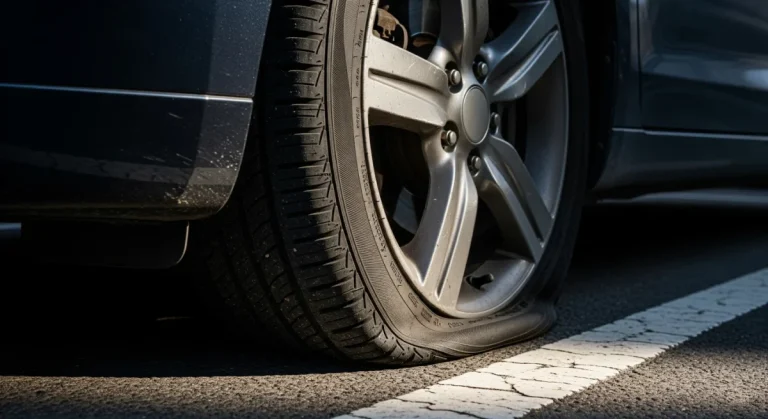How Long Before Your Car Battery Dies With the Radio On?
Key Takeaways
- Quick Answer: A healthy, fully-charged car battery can typically power a stock radio for 4 to 8 hours with the engine off. However, an older battery or a powerful aftermarket stereo will significantly shorten this time.
- Key Factors: The exact time depends on four things: your battery’s health, its capacity (Amp-hours), your radio’s power draw, and any other electronics you’re using.
- The Safe Bet: To avoid getting stranded, you should run your car’s engine for 10-15 minutes every hour. This allows the alternator to recharge the battery.
- Pro-Tip: For extended listening, like at a drive-in movie, a portable Bluetooth speaker is your best and safest option. It completely removes your car’s battery from the equation.
It’s a classic scenario. You’re waiting in your parked car, enjoying some music at the local park, or maybe you’re set up for a drive-in movie. You want your tunes, but a nagging question pops into your head: Will this kill my battery? Nobody wants to be the person asking for a jump-start because of a simple oversight.
The fear of being stranded is valid. Fortunately, understanding how your car’s electrical system works can remove the guesswork. This guide will provide a clear, data-driven answer to how long you can listen to your radio. We’ll break down the key factors, give you a simple way to estimate your time, and share practical tips to enjoy your music worry-free. This is essential knowledge for first-time car owners and seasoned drivers alike.
The Straightforward Answer: An Estimation Guide
At its core, your car battery’s life is a simple formula: BatteryCapacity/ComponentDraw=Runtime. Think of your battery’s capacity, measured in Amp-hours (Ah), as the size of its fuel tank. The power draw of your radio, measured in Amps (A), is how fast it uses that fuel.
While every car is different, we can make some solid estimates.
Estimated Radio Runtime Table
This table gives you a quick reference for how long your battery might last under different conditions. Always remember these are estimates for a fully charged battery.
| Battery Condition | Audio System Type | Estimated Runtime (Hours) |
| New / Healthy | Stock Factory Radio | 6 – 10 Hours |
| New / Healthy | Aftermarket System with Amplifier | 3 – 5 Hours |
| Older / Weak (3+ yrs) | Stock Factory Radio | 2 – 4 Hours |
| Older / Weak (3+ yrs) | Aftermarket System with Amplifier | 1 – 2 Hours |
As you can see, the difference is significant. Let’s explore why.
The 4 Key Factors That Determine Battery Life
The numbers in the table above vary so much because of four crucial variables. Understanding these will make you an expert in managing your car’s power.
1. Your Car Battery’s Health & Age
A brand-new battery performs at its peak. However, just like any rechargeable battery, a car battery degrades over time. After three to five years, its ability to hold a full charge is noticeably reduced.
This happens partly due to a process called sulfation, where lead sulfate crystals form on the battery plates. These crystals hinder the battery’s ability to charge and discharge efficiently.
2. The Battery’s Capacity (Ah and RC)
Capacity is king. Most car batteries have their Amp-hour (Ah) rating printed on the label—a typical number is around 45-55 Ah. A higher number means more energy storage.
For even better insight, look for the Reserve Capacity (RC) rating. This is a fantastic metric that measures the number of minutes a fully charged battery can supply 25 amps of power before its voltage drops too low to start the engine. A higher RC means your battery is better suited for running accessories with the engine off.
3. The Power Draw of Your Audio System
Not all radios are created equal. A basic, factory-installed radio might only draw 2-5 amps. In contrast, a modern infotainment system with a large screen, or an aftermarket stereo connected to a powerful amplifier and subwoofer, can easily pull over 15 amps, especially at a high volume. The louder you play your music, the more power you use.
4. Other “Parasitic Drains”
Your radio is rarely the only thing using power. When your car is in accessory mode, other components are often active. These “parasitic drains” add up.
Common drains include:
- Charging your phone through a USB port.
- A running dash cam.
- Interior dome or map lights.
- The HVAC blower fan (even with the A/C off).
Each of these seems small, but their cumulative effect can shorten your battery’s runtime. Properly managing your connected devices’ power draw is an important part of the puzzle.
How to Listen to the Radio Without Killing Your Battery
Now for the practical advice. Here are three simple strategies to enjoy your music without worry.
Use “Accessory Mode” (ACC) Correctly
Your car’s ignition has multiple positions. To save power, you want to be in Accessory (ACC) mode.
- Push-Button Start: Press the start/stop button without your foot on the brake pedal. The radio and outlets will turn on, but the engine systems remain off.
- Keyed Ignition: Turn the key to the first click. This is the ACC position.
Avoid turning the key to the “ON” or “RUN” position, as this powers up more components like the fuel pump and drains the battery much faster.
Run The Engine Periodically
This is the most reliable method. For every hour you listen to the radio, start the car and let it run for about 10-15 minutes. This allows the alternator to do its job and send a powerful charge back into the battery, effectively refilling its “tank.”
H3: Invest in a Portable Bluetooth Speaker
Honestly, this is the best solution for any planned, long-duration listening. For drive-in movies, tailgating, or camping, a portable speaker is a no-brainer. It has its own battery and completely protects your car’s electrical system.
Know the Warning Signs of a Low Battery
Your car will often give you clues before the battery goes completely flat. If you notice the radio display flickering, the audio cutting in and out, or your dashboard lights dimming, it’s a clear signal to start the engine immediately.
What to Do If Your Battery Is Already Dead
If it’s too late and the car won’t start, don’t panic. First, stop trying to crank the engine, as this can strain the electrical system.
Your two main solutions are a jump-start from another vehicle or using a portable jump starter pack. After a successful jump-start, you must drive the car for at least 30 minutes (preferably on a highway) to give the alternator enough time to put a meaningful charge back into the battery. Simply idling for 10 minutes is not enough. Knowing these steps is part of being prepared for any roadside situation.
Frequently Asked Questions
Does leaving the radio on in the car drain the battery?
Yes, absolutely. Any electronic component running while the engine is off draws power directly from the car battery. While a radio uses far less energy than headlights, it will steadily drain the battery over time.
Can a car battery be dead if the radio still works?
Yes, this is a very common scenario. Powering a simple radio requires a very small amount of electrical current. In contrast, starting an engine requires a massive burst of power. A battery can easily have enough energy to run the radio, but be far too depleted to turn the engine over.
How long can a car stay in accessory mode?
The duration depends entirely on the battery’s health, its capacity (rated in Amp-hours), and which accessories are active. A new, healthy battery might power a stock radio for 8+ hours. An older battery running a radio, a phone charger, and the interior fan might only last an hour or two.
How do I know if my radio is draining my car battery excessively?
The main symptom is if your battery dies after very short listening periods (e.g., under an hour), even though the battery is relatively new. This could signal an abnormal “parasitic draw” from faulty wiring in the audio system. A mechanic can perform a specific test to diagnose this issue.
Conclusion
So, can you listen to your car radio with the engine off? Definitely. For how long? It’s a balancing act. With a healthy battery and a stock radio, you can relax and listen for hours. But if you have an older battery or a high-powered sound system, you need to be much more mindful.
The smartest approach is to be prepared. Monitor the time, run your engine every hour to be safe, and for any marathon listening session, let a portable speaker do the heavy lifting. A little knowledge goes a long way in preventing the silence—and inconvenience—of a dead battery.






